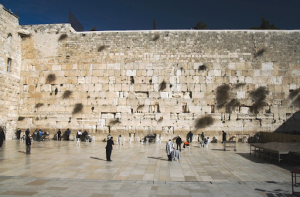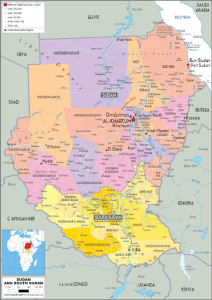In the modern day and across history, religion dictates a lot of political decisions across the globe. In the Western Hemisphere, Europe, and the Middle East, beliefs centered around Christianity, Judaism, and Islam govern most nations. Additionally, their divine viewpoints also affect how they handle and treat foreign policy, leading to bias, discrimination, and aggression on a global scale. It is imperative to understand the origin and history of the three major Abrahamic Religions to comprehend the effect of religion on the modern world.
Origins

Cr: Britannica (Lisa Lubin)
Despite their numerous differences, Christianity, Judaism, and Islam stem from a singular point and share commonalities. Christianity, Judaism, and Islam all share the same God and innumerable qualities, such as monotheism, a global flood, and countless other events. Each of the three believes in a singular prophet, Abraham, who would be the first to make a covenant with God. Additionally, each of the three religions views Jerusalem as the Holy City for their faiths; they share similar stories in their Holy Scriptures (Bible, Torah, and Quran) and some prophets up until Jesus. Jesus and the New Testament would mark the first major split within the Abrahamic Religions, as Jews didn’t believe in Jesus at all (thus, the New Testament is void for them). However, Christians accepted him as the Messiah and the next prophet. With Islam forming after Christianity, they also acknowledge the existence of Jesus and recognize him as a prophet instead of a divine prophet, meaning Jesus is not the son of God nor a figure in the Holy Trinity. That said, Muslims still treat Jesus with a similar level of respect as Christians due to his connections with the Islamic Prophet Muhammad. Ultimately, the three religions take vastly different paths in belief structures from their inception, resulting in internal and external strife between them. In a way, it displays that things of similar origin can still end up vastly different from one another. (1)
It is also important to note that Christianity, Islam, and Judaism go far beyond their umbrella title, as the two religions are home to different sects and derivations from the central belief. As Islam splits into Shia and Sunni and Christianity divulges into 45000 other deviations, each has varying interpretations of the rules within their religion. There are different conservative, nationalist, and liberal sects within Judaism, which also divide the population.
The 11th Century to 21st Century: A Story of Bloodshed
Understanding previous conflicts in which religion played a key factor is essential to assess how religion affects modern-day politics. The majority of religious dissonance today is an aftereffect of events spanning centuries in the past. Unfortunately, even in the centuries that have elapsed, there has yet to be a leadership figure or significant movement amongst the three Abrahamic religions to amend past atrocities and work on peacefully coexisting with one another; granted, such a task would be challenging in the first place, given the distinct nature that has divided Islam into its Sunni and Shia sects, the vast political landscape of 45000 Christian denominations, and the Jewish divide between Zionist and Traditional views, with the cherry on top being the poor external relationships between each of the major religions.
To begin, Christianity and Islam are no strangers to conflict. The most notable series of armed conflicts between Christian and Islamic faiths is the Crusades (there were previous disagreements before the Crusades; however, what the Crusades caused would have a lasting effect down the road), the first dating back to 1096. Pope Urban II initiated the First Crusade in response to the conflict between the Byzantine and Turkish Tribes. The Pope felt it necessary to assist the Byzantines after Emperor Komnenos submitted a request to the Church; the request was accepted due to a common faith. However, shortly after the First Crusade began, the war goal shifted from reclaiming lost Byzantium territory to reclaiming the Holy Land (Jerusalem), which had been under Muslim control for approximately 400 years at this point (Byzantium had lost the city in an earlier conflict). Ultimately, the assembled Christian Forces of the First Crusade would successfully reclaim numerous Byzantium territories within the Mediterranean, including Jerusalem. However, the siege of Jerusalem saw Christians massacring numerous Muslims and Jews, an event which had considerable implications regarding the viewpoints of the faiths during the period. At the end of the First Crusade, the Christian Kingdom of Jerusalem was established, making it a major battleground for the next Crusade. (2)
Unlike the first, the Second Crusade (1145 – 1149) was a complete and utter failure for the Christian combatants (led by France and Germany’s rulers), resulting in numerous casualties and some territory losses. The Second Crusade was in response to the fall of Edessa, which had been claimed by Muslim forces a few years prior. Following the victory of the Second Crusade, half a century later, in 1487, the third began, initiated by Muslims this time.(3) The Third Crusade consisted of a united Muslim force of Egyptian and Syrian soldiers led by Saladin, a Kurdish man and the first Sultan of Egypt-Syria, whose goal was to reclaim the city of Jerusalem. The Christian forces saw participation from the English, French, and Germans (although the French and Germans would make an early exit due to other European issues), with a significant difference between this Crusade and the previous being kings leading their soldiers into battle. At the end of the fighting, Jerusalem switched to Muslim occupancy and would remain that way for the six Crusades. Unlike the previous Christian owners, Muslims allowed Christians passage into Jerusalem (so long as they were unarmed) to worship their faith and see the city.(4) The remaining Crusades saw similar outcomes with Muslim Victories (except the sixth), however the near-continuous fighting between the two entities for two hundred years would only add to preexisting hatred (mostly fueled by the Christians) between the two religions.
From the 1200s to the 1800s, there were numerous conflicts between Christians and Muslims; however, none of which rivaled the scale of the Crusades. However, the political climate would significantly change after the end of World War II, with the creation of a Jewish State in Palestine. Using land that Great Britain had claimed from the now-dissolved Ottoman Empire at the end of World War I, Israel (like other nations in Africa and the Middle East) was carved out of land with pre-existing population groups, in this case, Palestinians. Before the arrival of Zionist Jews, Palestine had been home to a very diverse group of people from several walks of life. There were populations of Jews (Yishuv or Palestinian Jews), Christians, and Arabs who lived within the region relatively peacefully (as a result of the region changing hands between empires throughout history). (5) The region was thriving and teeming with life up until 1947, which marked the beginning of an event known as Nakba by the Palestinians. (6) Nakba refers to the ethnic cleansing of the Palestinian population to make room for Israel, which would be formed the following year on May 4, 1948(7). Nakba is a day of commemoration for Palestinians to remember all the lives lost since 1947; Israel doesn’t acknowledge Nakba and recognizes it as the nation’s day of independence. (6) The creation of Israel in predominantly Muslim territory has since led to countless conflicts and war in the region, the majority of which have religious intent behind them; the effects of Israel’s Birth holds a lasting impact on the modern world.

Cr: worldometers
Another region of interest is Sudan, which has been plagued with war and conflict since 1955. Like Palestine, Sudan was inherited by the British Empire following the end of World War I and the dissolution of the Ottoman Empire. The region remained under British Control until 1954, with Sudan officially claiming independence in 1956. As Sudan was decolonized by the British and Egyptians, both parties made the critical mistake (as they would with several other African territories) of splitting the land with no regard for ethical or religious differences within the region. Thus, Sudan, the most prominent (by size) African country, taking up a quarter of the United States, was an ethnic melting pot of over 600 ethnicities and 400 spoken languages. However, the initial Sudanese Civil War came to be due to a divide between the Christian South and Islamist North, as the South Sudanese believed the more predominant Islamic population would soon overrule and oppress them, the nation’s capital, Khartoum, also being located in the North didn’t help the situation either(8). With fear as their motivation, South Sudanese officers started the war by creating mutinies within the army and building a disorganized guerilla force. The First Sudanese Civil War lasted from 1955 – 1972, claiming a large amount of civilian lives during the combat (only 20% of the 500,000 casualties were armed combatants). Unfortunately, the First Sudanese Civil War would be a direct cause of the second, as the years between 1972 and 1983 were plagued with great mistrust and uncertainty between the two groups.
The Second Sudanese Civil War was the epitome of religious and ethnic differences in the region, culminating in one of the deadliest conflicts in the modern day. The Second Civil War began as a result of Sudanese President Nimeiry declaring Sudan as an all-Islamic State, subsequently voiding the South Sudan Autonomous Region, demanding its destruction and reintegration into Sudan. The war’s peak in 1992 would see the massacre of thousands in South Sudan as the Bashir regime aimed to ethnically cleanse the region through armed assaults, chemical warfare, and occupation. The fighting was fierce, and South Sudan had officially gained independence as a part of the peace deal. However, the region was far from stabilized, as internal conflicts sprouted in both South Sudan and Sudan proper; additionally, tensions between the two powers are high given how recent their last major conflict was(8)
21st Century

Cr: Getty Images
In the 21st century, a recent example of religious-based conflict comes from the U.S. War on Terror, which spanned multiple regions following Al Qaeda’s 9/11 attacks. What makes the War on Terror unique is it was a war on ideology, one the U.S. made constant effort to associate with Islamic Extremism in particular. Because of the narrative the U.S. military was spinning, the U.S.’s arbitrary target of war, and the disastrous day that is 9/11, hatred towards Arab-Americans grew exponentially, despite President Bush clarifying that they were not the targets of the U.S. government’s recent actions(9) (up 1617% from 2000 to 2001, according to the FBI)(10). The general American view of Arabian population groups within the country and globally shifted to a very negative light, introducing Islamophobia to Americans en masse, subsequently creating numerous negative stereotypes and perceptions regarding a large group of people. Thus, there became a point of commonality for hatred and hesitation when acting in foreign affairs, a subsequent bias based solely on ethnic and religious origins. “It’s very rarely Western countries and the Middle East working together, some issues everyone works together, like sanctions, but if it’s on humanitarian issues you’re going to have different views,” Fiona Peterson (11) adds. “This is because religion directly affects humanitarian causes.”
Additionally, the arbitrary War on Terror has left a lasting impression on Western powers in the Islamic World. As the United States operated in Afghanistan, Iraq, Yemen, Pakistan, Syria, Kuwait, and various other regions during the years from 2001 to 2020, at times, some humanitarian aspects were ignored. Chase Fournier (11) comments, “I would say Islam is very biased against both [Christianity and Judaism], mainly because the only Jewish state took over their entire Holy Land and proceeded to commit numerous war crimes. The U.S. did the same thing without taking land, just indiscriminately bombing them.” While “indiscriminately” may not be the best descriptive, the United States did employ a variety of bombing strategies during the war on terror, some of which included civilian casualties. “. . . Journalists began writing regularly about the aftereffects of cluster strikes-civilians killed by unexploded bomblets that littered the country, especially in the Shomali Plain and near Herat and Khanabad” (11). Given the nature of many Western Operations in the Islamic World and other conflicts in the past millennia, there is a lasting undertone of violence, mistrust, and hatred in the region. Given the current situation in Palestine, tensions between all three of the significant religious clusters will only continue to grow as the Israelis proceed with their next massacre. “I think the Israel conflict is fascinating because it’s not just Jewish and Muslim, but there’s also a Christian element because there are Palestinian Christians,” comments Peterson. “I find it very interesting how most of the Christian countries have tended to align themselves with the Jewish side of the conflict, generally, and recently, there’s been more conflict between Islam and Christianity.”
Religion has been a preface and focus point for numerous conflicts worldwide since its inception. People believe their actions can be justified through their beliefs or use their beliefs to construct narratives that better suit their actions. Truthfully, interreligious strife will exist as long as humanity willingly divides itself into separate belief systems without intending to understand or accept others for what they are. Until that gap is bridged, numerous wars will continue to stem from religion or have religion listed as a subsequent cause.



